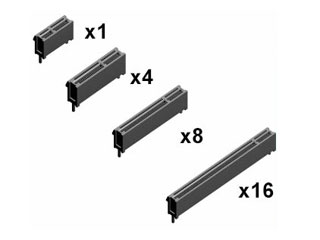 55
55
Ivy Bridge PCI-Express Scaling with HD 7970 and GTX 680 Review
Test Setup »Introduction

The last time we did an article on PCI-Express scaling, was when graphics cards were finally able to saturate the bandwidth of PCI-Express x16. Not only was it a time when PCI-Express 2.0 was prevalent, but also when the first DirectX 11 GPU hit the market, and that was over six years into the introduction of the PCI-Express bus interface. Since 2009, thanks to fierce competition between NVIDIA and AMD, GPU performance levels have risen at a faster rate than ever, and the latest generation of high-end GPUs launched by the two GPU rivals adds support for the new PCI-Express 3.0 interface. The new interface sprung new questions from users like "Do I need a new motherboard to run a PCI-Express 3.0 card?", "Will my new PCI-Express 3.0 card be much slower on an older motherboard?" or "My motherboard supports only x8 for multiple cards, will performance suck?"
The industry's first PCI-Express 8 GT/s-capable platform was released last year, with Intel's Sandy Bridge-E. SB-E isn't officially PCI-Express 3.0-certified; while AMD Southern Islands GPUs can function in PCI-Express 3.0 on the platform, NVIDIA's GeForce Kepler family of GPUs, so far, can't. The 22 nm Core processor family, codenamed Ivy Bridge, however, settles the issue by providing a PCI-Express 3.0-certified root-complex, and GPUs from both sides of the fence are tested to work on the new mode. PCI-Express 3.0 close to doubles the data bandwidth available to a connected device, per lane.

While PCI-Express 1.0 pushes 250 MB/s per direction, PCI-Express 2.0 pushes 500 MB/s, and PCI-Express 3.0 doubles that to 1 GB/s. While the resulting absolute bandwidth of PCI-Express 3.0 x16, 32 GB/s, might seem overkill, the ability to push that much data per lane could come to the rescue of configurations such as 8-lanes (x8) and 4-lanes (x4). Another impressive feature of Ivy Bridge Core processors, provided they're paired with Intel Z77 Express chipset, is that the second x8 link from the CPU root complex can be split as two x4 links, making x8/x4/x4 possible, giving some motherboards 3-way SLI and CrossFireX capabilities without clogging the DMI chipset bus (that 4 GB/s pipe between the CPU and chipset), which is better left untouched by graphics cards to help with today's bandwidth-hungry SSDs.

In this review, we test the impact of running the AMD Radeon HD 7970 and the GeForce GTX 680 on Intel Ivy Bridge PCI-Express slots that are electrically PCI-Express x16, x8 and x4. We tested all three generations of the PCI-Express interface: 1.1, 2.0 and 3.0.
This review is made possible thanks to an awesome BIOS option given to us by ASUS ROG Maximus V Gene motherboard, which allows us to toggle the CPU's PCI-Express root complex between PCI-Express 1.0, 2.0, and 3.0 modes. To modify the number of lanes available to the GPU, we used common plastic adhesive tape.
For your reference, we wrote similar articles in the past: GTX 480 PCIe Scaling, HD 5870 PCIe Scaling.
Apr 15th, 2025 04:12 EDT
change timezone
Latest GPU Drivers
New Forum Posts
- A dozen drivers for HD4670, and which do I choose? (18)
- TPU's Nostalgic Hardware Club (20246)
- Poor 1% lows on Shadow of Mordor - RTX 4060 mobile (0)
- [TechSpot] Breakthrough water filter eliminates forever chemicals using modified graphene oxide (3)
- Anime Nation (13024)
- JSBench.Me test results (12)
- 7800X3D and 5070 Ti / 9070 XT Build (15)
- Weird pc slow down as soon as PCI-E card is in the system (9)
- best ram to buy for my usage and system specs? (34)
- Gigabyte 9070 XT audio issues (35)
Popular Reviews
- G.SKILL Trident Z5 NEO RGB DDR5-6000 32 GB CL26 Review - AMD EXPO
- ASUS GeForce RTX 5080 TUF OC Review
- Thermaltake TR100 Review
- The Last Of Us Part 2 Performance Benchmark Review - 30 GPUs Compared
- TerraMaster F8 SSD Plus Review - Compact and quiet
- Zotac GeForce RTX 5070 Ti Amp Extreme Review
- Sapphire Radeon RX 9070 XT Pulse Review
- DAREU A950 Wing Review
- Sapphire Radeon RX 9070 XT Nitro+ Review - Beating NVIDIA
- Upcoming Hardware Launches 2025 (Updated Apr 2025)
Controversial News Posts
- NVIDIA GeForce RTX 5060 Ti 16 GB SKU Likely Launching at $499, According to Supply Chain Leak (182)
- NVIDIA Sends MSRP Numbers to Partners: GeForce RTX 5060 Ti 8 GB at $379, RTX 5060 Ti 16 GB at $429 (124)
- Nintendo Confirms That Switch 2 Joy-Cons Will Not Utilize Hall Effect Stick Technology (105)
- Over 200,000 Sold Radeon RX 9070 and RX 9070 XT GPUs? AMD Says No Number was Given (100)
- Nintendo Switch 2 Launches June 5 at $449.99 with New Hardware and Games (99)
- Sony Increases the PS5 Pricing in EMEA and ANZ by Around 25 Percent (85)
- NVIDIA PhysX and Flow Made Fully Open-Source (77)
- NVIDIA Pushes GeForce RTX 5060 Ti Launch to Mid-April, RTX 5060 to May (77)